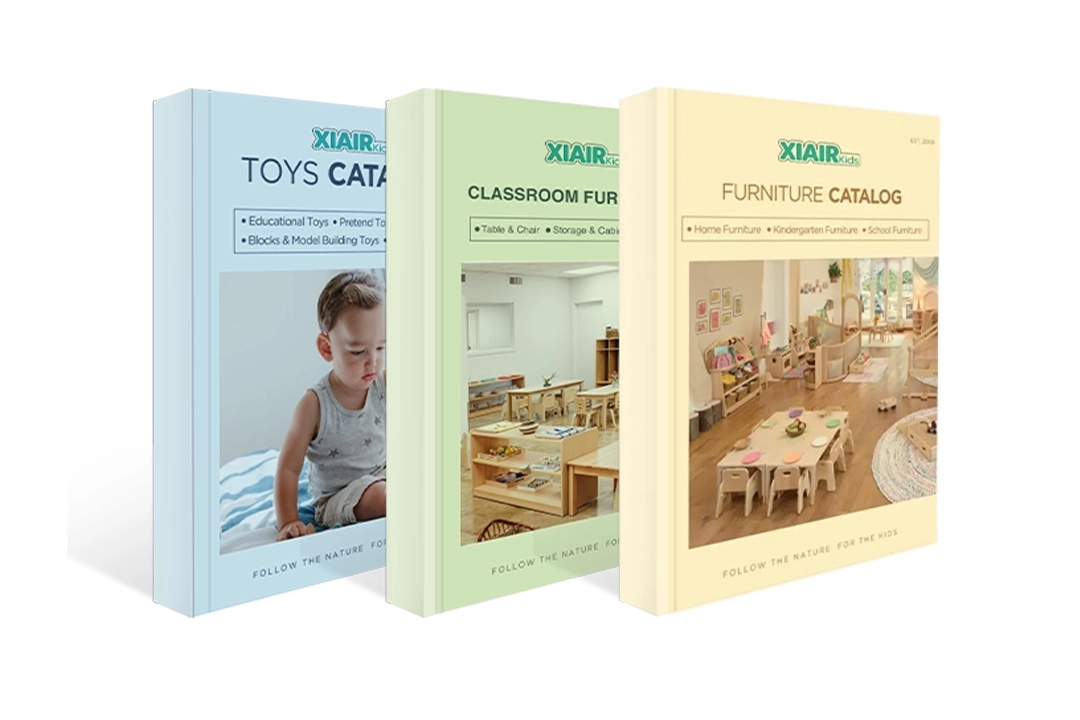Muitos professores de salas de aula da educação infantil desejam criar um espaço onde as crianças possam explorar livremente a linguagem, as letras e os livros, mas montar centros de alfabetização pré-escolar pode parecer confuso. Com tantos materiais, espaço limitado e uma ampla gama de níveis de desenvolvimento a serem considerados, é difícil saber por onde começar.
A solução está em construir um centro simples, bem organizado e adaptado às necessidades das crianças pequenas. Seja em uma creche, uma sala de aula de educação infantil ou um ambiente multi-idade para a primeira infância, a configuração certa pode fazer toda a diferença. Concentrando-se no posicionamento dos móveis, na seleção dos materiais e no fluxo da sala de aula, você pode criar centros de alfabetização pré-escolar que realmente incentivem a exploração independente.
Quando bem feitos, esses centros se tornam mais do que apenas um cantinho com livros — eles se transformam em centros de aprendizagem diária. As crianças ganham confiança no uso de letras, reconhecem palavras familiares e começam a fazer conexões entre sons e letras — tudo em um espaço seguro, familiar e divertido. E a melhor parte? Você não precisa de equipamentos sofisticados nem de um orçamento enorme para começar.
Introdução
Neste artigo, abordaremos tudo o que você precisa saber para construir centros de alfabetização pré-escolar que sejam simples, funcionais e adequados ao desenvolvimento. Seja para a primeira vez ou para a reforma de um espaço existente, o objetivo é o mesmo: criar um ambiente de leitura e escrita que realmente funcione para seus alunos.
Abordaremos o que são centros de alfabetização pré-escolar, os tipos mais comuns encontrados em salas de aula para a primeira infância, como montar um do zero e dicas para mantê-lo organizado e envolvente. Você também terá ideias para centros de alfabetização pré-escolar que seguem temas sazonais — como abóboras no outono ou Natal em dezembro — para ajudar a manter as coisas novas e divertidas o ano todo.
Não importa o tamanho da sua sala de aula, orçamento ou nível de experiência, este guia foi criado para oferecer ajuda prática e real na construção de ambientes ricos em alfabetização que apoiem os primeiros alunos todos os dias.
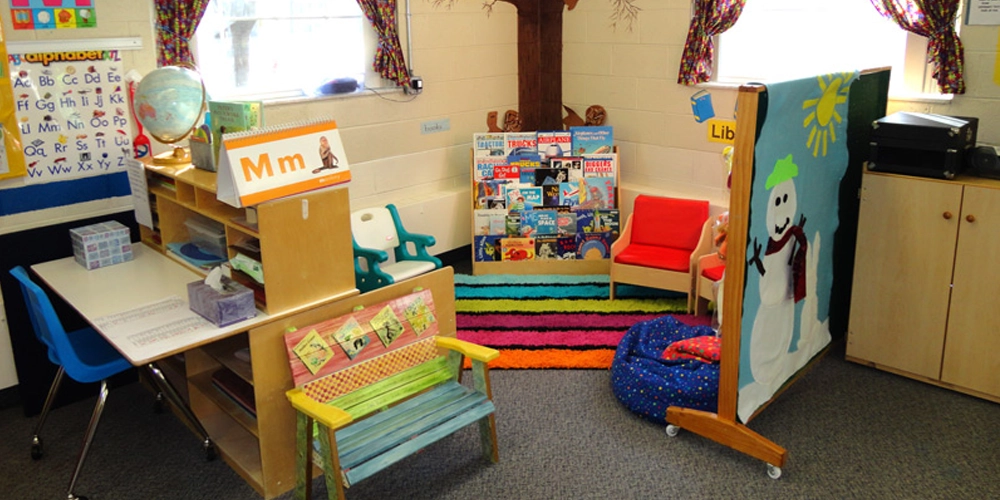
O que os centros de alfabetização pré-escolar fazem?
Um centro de alfabetização pré-escolar é um espaço na sala de aula onde crianças pequenas podem explorar habilidades iniciais de leitura e escrita por meio de atividades práticas e materiais significativos. Não é apenas um cantinho de leitura ou um lugar para guardar livros — é um espaço cuidadosamente projetado que apoia o aprendizado natural da linguagem nas crianças nos primeiros anos.
Em um centro de alfabetização pré-escolar bem projetado, as crianças têm liberdade para interagir com livros, letras, sons e ferramentas simples de escrita. Elas podem folhear livros ilustrados, recontar histórias com fantoches, combinar letras, desenhar seus nomes ou ouvir leituras gravadas em voz alta. Essas ações aparentemente pequenas estabelecem a base para habilidades de alfabetização mais amplas — como a percepção da escrita, o processamento fonológico e a confiança inicial na escrita.
Mas o propósito dos centros de alfabetização pré-escolar vai além do desenvolvimento de habilidades. Esses centros proporcionam independência às crianças. Eles permitem que elas escolham o que lhes interessa, repitam atividades que gostam e desenvolvam o foco — tudo em um espaço calmo, familiar e criado especialmente para elas. Em uma creche ou sala de aula de educação infantil barulhenta e frequentemente movimentada, esse tipo de autonomia pode fazer uma grande diferença.
Outro papel do centro de alfabetização pré-escolar é estruturar o ambiente de aprendizagem. Ele oferece um "lar" para a leitura e a escrita na sala de aula. As crianças sabem onde estão os livros. Sabem onde encontrar papel e giz de cera. Sabem que não há problema em explorar as letras, mesmo que ainda não saibam soletrar. Essa familiaridade gera confiança e incentiva o uso regular de ferramentas de alfabetização ao longo do dia.
Em muitos centros de alfabetização para pré-escola, você também encontrará estações para pequenos grupos ou rodízio. Essa configuração permite que os professores trabalhem com algumas crianças por vez, enquanto as demais estão ocupadas com tarefas independentes. Quando usado de forma consistente, o centro de alfabetização para pré-escola se torna um dos espaços mais produtivos da sala de aula.
A melhor parte? Centros de alfabetização pré-escolar são flexíveis. Você não precisa de um espaço grande ou equipamentos caros para fazer um funcionar. Mesmo em uma creche pequena, um centro de alfabetização pré-escolar pode ser criado com apenas uma prateleira baixa, alguns materiais bem escolhidos e um tapete aconchegante.
Em suma, o centro de alfabetização pré-escolar é onde a linguagem ganha vida. Ele apoia a alfabetização em centros pré-escolares não apenas ensinando habilidades, mas também tornando a leitura e a escrita uma experiência natural e cotidiana.
Tipos de estações de alfabetização comuns na pré-escola
Um centro de alfabetização pré-escolar completo geralmente inclui vários tipos de estações. Cada estação se concentra em um aspecto diferente da alfabetização inicial e desempenha um papel na criação de um ambiente equilibrado para os jovens aprendizes. Essas estações não precisam ser grandes ou complexas — elas simplesmente precisam ser acessíveis, envolventes e intencionais.
Aqui estão cinco tipos comuns de estações de alfabetização usadas em salas de aula de educação infantil e creches:
Estação de Leitura
O espaço de leitura é o coração de muitos centros de alfabetização pré-escolar. É um cantinho aconchegante e tranquilo onde as crianças podem sentar, relaxar e explorar os livros sozinhas. Você não precisa de mais do que um tapete macio, algumas almofadas e uma estante com livros ilustrados apropriados para a idade. O espaço deve ser convidativo e tranquilo, longe de áreas barulhentas ou com muito movimento na sala de aula.
Para tornar esta área funcional, faça a rotação dos livros de acordo com os temas, estações do ano ou interesses das crianças. Use estantes baixas e abertas para que as crianças possam ver as capas, não apenas as lombadas. Esta estação ajuda as crianças a desenvolver o amor pelos livros, a desenvolver habilidades de compreensão precoce e a começar a reconhecer palavras e caracteres familiares.
Estação de Escrita
A estação de escrita oferece às crianças a oportunidade de explorar marcas, letras e palavras de forma lúdica. Esta área não requer uma configuração sofisticada — apenas uma mesa pequena, cadeiras de tamanho infantil e recipientes com papel em branco, giz de cera, lápis e marcadores.
Para promover a independência, rotule os materiais de forma clara e ofereça opções. Você pode incluir cartões com nomes, carimbos com o alfabeto ou pranchetas para incentivar a escrita durante as brincadeiras de faz de conta. Coloque o local de escrita perto da área de leitura ou do centro de artes para que as crianças possam transitar naturalmente entre a expressão criativa e a linguagem escrita.
Centros de alfabetização em salas de aula pré-escolares frequentemente integram esse espaço às rotinas diárias, incentivando as crianças a “escrever” listas de compras, mensagens ou etiquetas para seus desenhos.
Estação de Escuta
A estação de escuta permite que as crianças ouçam a linguagem por meio de histórias, músicas ou leituras gravadas em voz alta. Geralmente, inclui um par de fones de ouvido, um tocador de áudio simples e uma cesta de livros com as gravações correspondentes. Esta estação ajuda a desenvolver a compreensão auditiva e apoia crianças que ainda não se sentem confiantes para falar ou ler em voz alta.
Mantenha o espaço compacto e coloque-o perto de uma parede ou canto para reduzir distrações. As crianças podem usar este espaço de forma independente depois de aprenderem a usar o áudio. É especialmente útil em creches, onde a leitura em grupo nem sempre é possível.
As estações de escuta também dão suporte a alunos que estão aprendendo uma segunda língua e proporcionam uma pausa tranquila das atividades em grupo.
Estação do Alfabeto e Vocabulário
Esta é uma área prática onde as crianças trabalham com letras, palavras e associações entre palavras e imagens. Use quadros magnéticos, quebra-cabeças de alfabeto, peças com letras ou cartões de vocabulário temáticos. Organize as atividades por tema — cores, animais, clima, etc. — para mantê-las envolventes e relevantes.
Coloque esta estação perto de um mural de palavras ou quadro de exibição visual. As crianças podem ficar em pé ou sentadas, classificar letras, combinar figuras com palavras impressas ou construir seus nomes usando letras móveis. Em centros de alfabetização e aprendizagem pré-escolar, esta área desempenha um papel importante para ajudar as crianças a fazer conexões iniciais entre letras e sons sem instruções formais.
Para torná-lo mais interativo, troque os materiais semanalmente e inclua elementos sazonais, como cartões de palavras de abóbora ou jogos de vocabulário com temas natalinos.
Estação de Consciência Fonológica
Esta estação se concentra em brincar com sons — rimas, sílabas e sons iniciais. Você pode oferecer jogos de cartas com rimas, tapetes de classificação de figuras ou atividades simples de palmas. É a mais abstrata das estações, mas ainda pode ser divertida e acessível.
Use músicas, acessórios e livros com foco em sons para introduzir esses conceitos naturalmente. Evite exercícios de simulação; em vez disso, incentive a exploração. Instale esta estação em um local mais tranquilo, talvez perto do centro de audição, onde as crianças possam se concentrar em jogos baseados em sons.
As atividades dos centros de alfabetização pré-escolar nesta categoria funcionam melhor quando vinculadas a histórias ou músicas que as crianças já gostam.
Estes cinco tipos de estações ajudam a organizar seus centros de alfabetização para a pré-escola de forma flexível, gerenciável e significativa. Você pode adaptar o layout com base no espaço, alternar os materiais com base nos temas e dimensionar cada área de acordo com a configuração da sua sala de aula.
Não importa quanto espaço você tenha, mesmo duas ou três estações bem planejadas podem criar uma base sólida para fazer conexões de alfabetização em centros pré-escolares e, mais importante, manter as crianças envolvidas e animadas com o aprendizado.
Por que os centros de alfabetização devem estar presentes em todas as salas de aula da pré-escola
Quando bem executados, os centros de alfabetização pré-escolar são uma das ferramentas mais eficazes na educação infantil — não apenas para desenvolver habilidades linguísticas, mas também para criar estrutura, independência e curiosidade nos jovens alunos. Esses centros não são um extra — são essenciais para salas de aula que desejam apoiar todo o desenvolvimento da alfabetização, desde a consciência sonora inicial até a narração de histórias e a comunicação com confiança.
Não importa se você trabalha em uma pré-escola formal, em uma creche ou em um espaço de aprendizagem inicial em casa: ter centros de alfabetização designados torna o aprendizado de idiomas consistente, lúdico e acessível para todas as crianças.
Acesso à alfabetização durante todo o dia
Um dos motivos mais importantes para incluir centros de alfabetização pré-escolar é que eles oferecem às crianças acesso contínuo a materiais de linguagem. Em vez de esperar por instruções do professor, elas têm a liberdade de interagir com livros, cartas e materiais de escrita ao longo do dia, de uma forma natural e pessoal.
Esse contato frequente e informal com letras e palavras cria familiaridade e conforto. Quando as crianças são cercadas por textos impressos e convidadas a explorá-los à sua maneira, elas começam a desenvolver hábitos de leitura e escrita muito antes de conseguirem decodificar textos.
Escolha e Independência na Aprendizagem
Em centros de alfabetização pré-escolar bem projetados, as crianças são incentivadas a escolher o que querem fazer — seja recontar uma história com fantoches, desenhar letras na areia ou escrever listas de compras de mentirinha.
Essa escolha promove a independência. Permite que as crianças sigam sua curiosidade, tomem decisões e desenvolvam confiança em suas próprias habilidades. Com o tempo, isso leva a uma conexão mais profunda e pessoal com a leitura e a escrita — porque elas sentem que a leitura e a escrita são suas, e não algo imposto.
E quando as crianças se sentem no controle de sua aprendizagem, elas têm mais probabilidade de retornar à atividade repetidamente, desenvolvendo fluência por meio da repetição e da alegria.
Como os centros de alfabetização pré-escolar melhoram o fluxo da sala de aula
Da perspectiva do professor, os centros de alfabetização pré-escolar não são bons apenas para a aprendizagem, mas também para a gestão da sala. Ao dividir as crianças em pequenos grupos ou oferecer tarefas independentes, os professores podem reduzir o ruído, facilitar a transição e apoiar diferentes alunos sem caos.
Mesmo em espaços menores, como creches domiciliares ou salas de aula mistas, esses centros estruturam o dia. Você pode orientar os alunos em relação aos objetivos de aprendizagem enquanto outros permanecem engajados em suas estações, praticando habilidades sem a necessidade de instruções diretas de adultos.
A melhor parte? Esses centros são escaláveis. Não importa se você tem uma sala de aula lotada ou apenas um cantinho tranquilo, você pode fazer com que os centros de alfabetização pré-escolar funcionem com o espaço e os recursos disponíveis.
O Poder do Espaço e do Design
Onde e como você posiciona seus materiais pode mudar completamente a forma como as crianças interagem com eles. Uma cesta de livros aberta é mais convidativa do que uma prateleira alta e fechada. Etiquetas claras e mesas na altura das crianças incentivam a exploração independente, enquanto o espaçamento cuidadoso entre os centros ajuda a evitar distrações e incentiva o engajamento contínuo.
Ao projetar seus centros de alfabetização e aprendizagem pré-escolar com propósito, você convida as crianças a entrar e as guia na exploração sem que elas precisem dizer uma palavra. Um posto de escuta ou quadro com o alfabeto bem posicionado pode se tornar um local favorito simplesmente por ser de fácil acesso, visualmente envolvente e claramente pensado para elas.
Mantendo os Centros Atualizados com Temas e Estações
Um dos motivos pelos quais os professores adoram usar centros de alfabetização pré-escolar é que eles são fáceis de atualizar. Trocando apenas alguns livros ou cartões de atividades, você pode alinhar os centros com feriados, temas da sala de aula ou estações do ano.
- Em outubro, experimente centros de alfabetização de abóboras para pré-escola com cartões de vocabulário temáticos, atividades de rimas com abóboras ou caça às letras com temas de outono.
- Em dezembro, adicione centros de alfabetização natalinos, atividades pré-escolares como escrever cartas para o Papai Noel, cartões de histórias com temas natalinos ou jogos de correspondência de sons com vocabulário festivo.
- Durante a primavera, use jogos de palavras baseados na natureza, quadros de letras com temas de jardim ou cartões de vocabulário de insetos para dar relevância sazonal ao seu centro.
Essas pequenas mudanças mantêm o ambiente de aprendizagem novo e estimulante, ao mesmo tempo em que reforçam as habilidades básicas de alfabetização. Mais importante ainda, elas mostram às crianças que ler e escrever fazem parte do dia a dia, independentemente da época do ano.
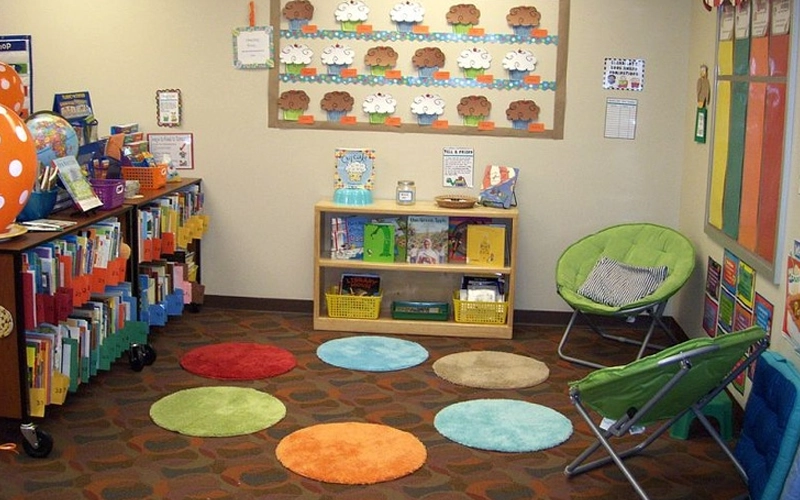
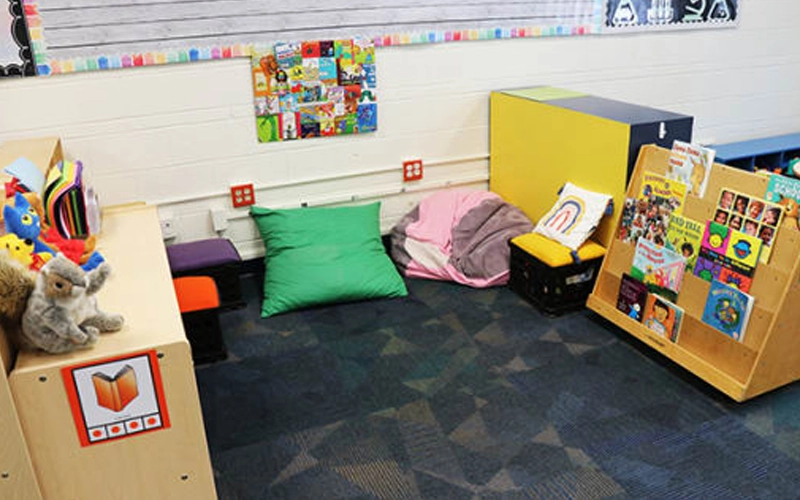
Configurando o espaço para um centro de alfabetização pré-escolar
Um espaço bem planejado é o que transforma materiais básicos em centros de alfabetização pré-escolar significativos. Não se trata de ter a maior sala de aula ou as ferramentas mais caras — trata-se de ser intencional. Seja trabalhando em uma pré-escola pública, creche particular ou um programa de educação infantil domiciliar, a forma como você configura seu espaço de alfabetização faz uma enorme diferença no engajamento das crianças.
Esta seção mostrará como criar um centro de alfabetização pré-escolar que se adapte ao seu espaço — seja ele grande ou pequeno — e atenda às necessidades de desenvolvimento dos seus filhos. Da escolha do local certo à seleção de móveis e materiais, cada decisão que você tomar determinará o sucesso dos seus centros de alfabetização pré-escolar.
Decida onde e quão grande o centro deve ser
Escolher o local certo para seus centros de alfabetização pré-escolar é o primeiro e mais importante passo. O objetivo é fazer com que a alfabetização seja uma parte natural da sala de aula, não uma tarefa separada ou isolada. Seja uma sala espaçosa ou um cantinho na creche, o segredo é criar um espaço que convide à calma, à concentração e à exploração.
Um bom centro de alfabetização pré-escolar deve ser instalado longe de áreas barulhentas ou de grande circulação. Cantinhos, perto de uma janela ou ao lado de um tapete de leitura são excelentes locais. Mesmo que você não tenha muito espaço, uma mesa pequena com algumas cestas e uma estante frontal podem fazer maravilhas.
Para ajudar você a determinar o tamanho certo do seu centro, aqui está um guia rápido com base no tipo de sala de aula e no número de crianças:
| Tipo de sala de aula | Área sugerida | Tamanho ideal do grupo | Notas |
|---|---|---|---|
| Pequena creche domiciliar | 1,5–2 m² | 1–2 crianças | Use armazenamento móvel ou um canto de leitura |
| Pré-escola (uso de meia aula) | 2–3 m² | 2–4 crianças | Defina o espaço com um tapete ou prateleiras baixas |
| Sala de aula pré-escolar completa | 3–5 m² | 4–6 crianças | Área dedicada com múltiplas zonas de alfabetização |
| Sala Multiuso Compartilhada | Flexível/Móvel | 1–3 crianças | Use carrinhos, lixeiras ou estações pop-up |
Tente evitar colocar o centro perto da sua área de blocos ou da área de brincadeiras dramáticas. Em vez disso, combine-o com centros tranquilos, como arte ou escrita, para estimular a concentração.
Criar um espaço do tamanho certo transmite uma mensagem poderosa: a alfabetização importa aqui. Mesmo os menores centros de alfabetização pré-escolar podem ter um grande impacto quando bem localizados e dimensionados de acordo com as necessidades dos seus alunos.
Escolha Móveis Isso funciona para crianças
Os móveis que você escolhe para os seus centros de alfabetização pré-escolar não se limitam à funcionalidade — eles transmitem uma mensagem. Dizem às crianças: "Você pertence a este lugar. Este é o seu espaço para explorar histórias, letras e linguagem."
Bons móveis ajudam as crianças a se movimentarem livremente, fazerem escolhas de forma independente e permanecerem engajadas por mais tempo. Eles promovem não apenas o conforto e a segurança, mas também comportamentos de aprendizagem que promovem o desenvolvimento da alfabetização precoce. Seja em um cômodo específico ou em um único canto, essas peças podem fazer uma grande diferença.
Móveis essenciais para centros de alfabetização pré-escolar
Aqui estão oito peças de mobiliário e configurações altamente eficazes que apoiam o desenvolvimento da alfabetização e o fluxo da sala de aula:
- Cantinho de Leitura (Estilo Tenda ou Cubículo)
Um cantinho especial oferece às crianças um espaço calmo e aconchegante, onde podem ler sem distrações. Adicione uma cortina, iluminação suave e assentos confortáveis. Mesmo em salas de aula pequenas, uma tenda de canto ou um cantinho retrátil cria uma atmosfera mágica de leitura. - Estante Frontal
As estantes tradicionais escondem as lombadas; as frontais exibem as capas. Esse acesso visual incentiva as crianças a explorar os livros por conta própria. Use temas (estações do ano, emoções, animais) para alternar os livros semanalmente e manter a curiosidade viva. - Mesa de estação de audição com fones de ouvido duplos
Isso permite que as crianças se envolvam com histórias em áudio usando fones de ouvido ou divisores compartilhados. Adicione um player digital, códigos QR para histórias gravadas e livros ilustrados correspondentes. É uma ótima opção para creches ou grupos de diferentes idades. - Mesa de escrita infantil com materiais
Equipe a mesa com pranchetas, mini cadernos, carimbos de letras e folhas de papel vegetal. Coloque esta área perto de um mural de palavras ou pôster do alfabeto para que as crianças possam copiar e explorar as letras de forma significativa. - Prateleiras de armazenamento baixas e abertas
Mantenha os materiais visíveis e etiquetados — letras magnéticas, cartões de identificação, caixas de som e quebra-cabeças. A independência se desenvolve quando as crianças conseguem recuperar e limpar os materiais sozinhas. - Caixa de correio ou centro de mensagens
Seja comprada em loja ou feita à mão, uma caixa de correio ensina propósitos práticos da escrita. As crianças podem enviar desenhos, escrever seus nomes ou deixar bilhetes para os amigos. Ela cria conexão emocional e reforça a alfabetização. - Quadro de Contação de Histórias ou Teatro de Marionetes
Use flanelógrafos, cartões de histórias ou fantoches simples. Este espaço promove a linguagem oral, a sequência e a dramatização ligadas a temas de alfabetização. - Assentos macios móveis
Pufes leves, mini cadeiras de balanço, pufes ou assentos acolchoados no chão dão liberdade de movimento às crianças. Coloque-os perto de estantes ou centros de audição para que as crianças possam escolher onde se sentem confortáveis para ler ou escrever.
Dicas para espaços pequenos ou compartilhados
Se você trabalha em uma pré-escola domiciliar ou tem espaço limitado, móveis multifuncionais são essenciais. Experimente:
- Carrinhos de rolamento com caixas etiquetadas que guardam materiais de escrita
- Mesas de colo dobráveis para escrita flexível em qualquer lugar da sala
- Prateleiras de exposição de livros sobre rodas que funcionam também como divisores de espaço
- Almofadas empilháveis para círculos de leitura que armazenam facilmente
Essas ferramentas flexíveis facilitam a instalação ou a organização de centros de alfabetização pré-escolar a qualquer hora do dia, ideais para salas de aula compartilhadas ou áreas de aprendizagem temporárias.
Por que a escolha dos móveis é importante
Quando as crianças sentem que o centro de alfabetização pré-escolar é realmente delas — física e emocionalmente —, elas retornam com mais frequência. É por isso que cada prateleira, cadeira e mesa importam. Você não está apenas escolhendo móveis. Você está moldando a maneira como as crianças se relacionam com a linguagem.
Um centro de alfabetização pré-escolar bem mobiliado não é apenas visualmente atraente — é uma ferramenta para aprendizado diário, foco tranquilo e descoberta alegre.
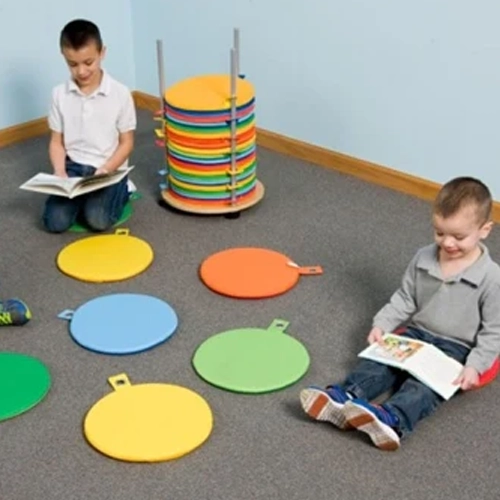
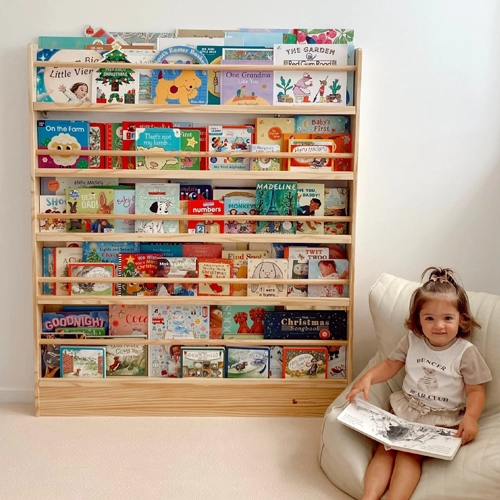
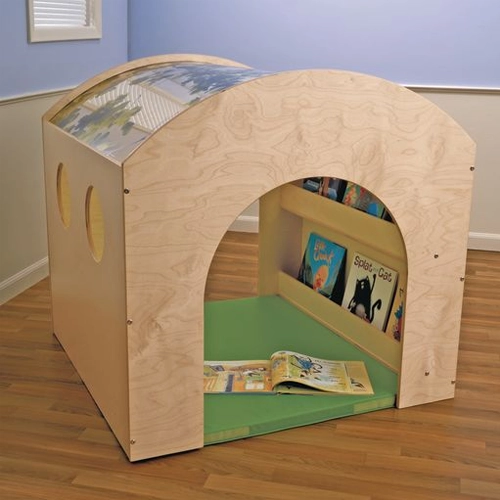
Crie uma seleção de livros que as crianças queiram explorar
Os livros são a essência de todos os grandes centros de alfabetização pré-escolar. Mas não se trata apenas de ter muitos livros — trata-se de ter os livros certos. Quando os livros que você escolhe despertam os interesses das crianças, refletem suas experiências e desafiam seu pensamento, o centro de alfabetização pré-escolar se torna um lugar ao qual elas adoram voltar todos os dias.
As melhores coleções de livros são equilibradas, diversas e dinâmicas. As crianças devem encontrar livros que as façam rir, pensar, sentir e se maravilhar.
Que tipos de livros devem ser incluídos?
Em centros de alfabetização eficazes na pré-escola, os livros devem apoiar uma variedade de habilidades de alfabetização — do desenvolvimento de vocabulário à contação de histórias e à compreensão. Considere incluir:
- Livros ilustrados com ilustrações vívidas e linguagem rica
- Livros sem palavras que incentivam as crianças a inventarem suas próprias histórias
- Livros Interativos como páginas texturizadas ou de aba levantada
- Livros de alfabeto e fonética para desenvolver a consciência precoce das letras e dos sons
- Livros com repetição ou rima, que auxiliam na memória e na fluência
- Livros bilíngues ou multiculturais que refletem a diversidade da sala de aula
- Livros relacionados a temas atuais—estações, feriados, animais, sentimentos
Quantos livros devem estar disponíveis?
Mais nem sempre é melhor. Uma coleção de 15 a 25 livros, rotacionados a cada uma ou duas semanas, costuma ser o ideal. As crianças se envolvem mais quando não são sobrecarregadas por opções.
Mantenha uma mistura de favoritos familiares e novos títulos para criar equilíbrio. Clássicos como Urso pardo, urso pardo ou A Lagarta Muito Faminta pode coexistir com títulos mais novos ou sazonais.
Organizando livros para acesso e independência
As crianças devem ser capazes de encontrar e devolver livros sem a ajuda de adultos. Use:
- Visores frontais, então as capas ficam visíveis
- Caixas etiquetadas com ícones (animais, ABC, sentimentos)
- Adesivos codificados por cores agrupar livros por tópico ou nível
- UM Estande “Livro da Semana” para destacar novos favoritos
Coloque os livros na altura dos olhos e agrupe-os por categoria, tema ou tipo. Deixe as crianças ajudarem a decidir o que colocar no centro de alfabetização pré-escolar — essa apropriação aumenta a motivação.
Onde encontrar livros para o seu centro de alfabetização pré-escolar
Montar sua biblioteca não precisa ser caro. Muitos centros de alfabetização pré-escolar utilizam:
- Rotações de bibliotecas públicas (trocar semanalmente ou quinzenalmente)
- Livros doados de famílias ou campanhas comunitárias
- Livros digitais ou audiolivros com código QR
- Pacotes de livros sazonais de bolsas de alfabetização ou livrarias locais
Até mesmo livros feitos em casa — desenhos grampeados ou histórias em fotos — podem se tornar tesouros na sala de aula quando as crianças se sentem conectadas a eles.
Livros são mais do que histórias — são espelhos, janelas e portas. Uma coleção de livros bem pensada transforma seus centros de alfabetização pré-escolar em um mundo de escolhas e oportunidades.
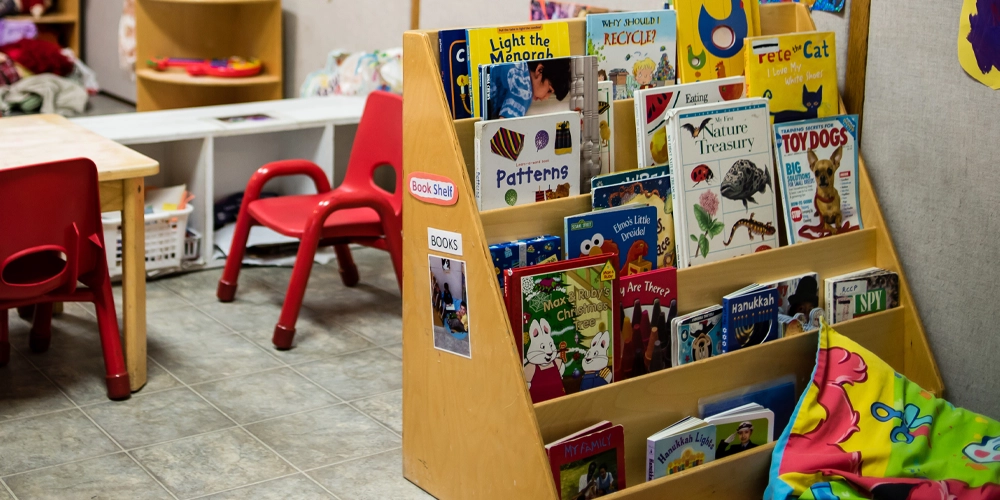
Adicione materiais que incentivem a leitura e a escrita
Os livros são essenciais, mas são os materiais práticos que dão vida aos seus centros de alfabetização pré-escolar. Esses materiais oferecem às crianças maneiras de praticar letras, sons e histórias de maneiras divertidas e significativas. Eles não são apenas extras — são ferramentas que convidam as crianças a explorar, criar e se conectar.
Para que seu centro de alfabetização pré-escolar pareça vivo e em constante mudança, concentre-se na variedade. Os materiais devem refletir o que as crianças estão aprendendo, suas curiosidades e o que veem no mundo ao seu redor.
1. Ferramentas de escrita que convidam à exploração
Comece com o básico — lápis, giz de cera e marcadores — mas vá além. As crianças adoram escrever quando as ferramentas parecem especiais.
- Giz de cera, lápis, canetas coloridas
- Pranchetas com papel pautado ou em branco
- Mini cadernos ou livretos dobrados
- Quadros brancos com instruções simples
- Notas adesivas para letras ou etiquetas falsas
- Envelopes, cartões postais e papel “correspondente”
Mantenha as ferramentas organizadas em cestos ou bandejas. Quando o espaço está limpo e acessível, as crianças têm mais probabilidade de usá-lo repetidamente.
2. Manipulativos de letras e palavras
Crianças em idade pré-escolar aprendem melhor quando podem tocar e mover o que estão fazendo. Ofereça opções simples e táteis, como:
- Letras magnéticas
- Quebra-cabeças do alfabeto
- Carimbos de letras com tinta lavável
- Cartões de imagem com correspondência de som
Nem tudo precisa ser novo. Até mesmo assadeiras reaproveitadas ou blocos de papelão podem se tornar ferramentas de alfabetização com um pouco de criatividade.
3. Materiais para Contação de Histórias e Sequenciamento
Ajudar as crianças a recontar ou criar histórias estimula a memória, a compreensão e o vocabulário.
- Peças de feltro para histórias clássicas
- Fantoches que combinam com livros favoritos
- Dados de história com ilustrações para misturar e combinar
- Cartões de história caseiros com imagens simples de personagens
Deixe as crianças misturarem peças para inventar novas histórias ou encenar livros que elas já conhecem.
4. Impressão funcional e textos do dia a dia
A leitura na vida real é poderosa. Deixe as crianças "lerem" os tipos de texto que veem os adultos usando.
- Cardápios de restaurantes reais
- Cartões de receitas com fotos passo a passo
- Horários de aula com símbolos simples
Esses materiais ajudam as crianças a entender que a impressão tem um propósito — e que elas também podem usá-la.
5. Materiais sazonais e rotativos
Mudar os materiais do seu centro de alfabetização pré-escolar é uma das maneiras mais fáceis de manter as crianças engajadas. Experimente:
- Cartões de vocabulário da Apple no outono
- Quebra-cabeças de palavras com flocos de neve no inverno
- Mini livros “sobre mim” em setembro
- Selos e papelaria temáticos perto dos feriados
- Cartões de animais ou leitores de não ficção durante estudos de unidade
Você não precisa mudar tudo de uma vez: apenas um ou dois itens novos podem renovar todo o espaço.
As crianças retornam a centros que parecem vivos, acessíveis e que valem a pena explorar. Os materiais que você escolhe tornam isso possível. E quando seus centros de alfabetização pré-escolar estão repletos de itens divertidos e significativos, as crianças não apenas praticam a alfabetização — elas a vivenciam.
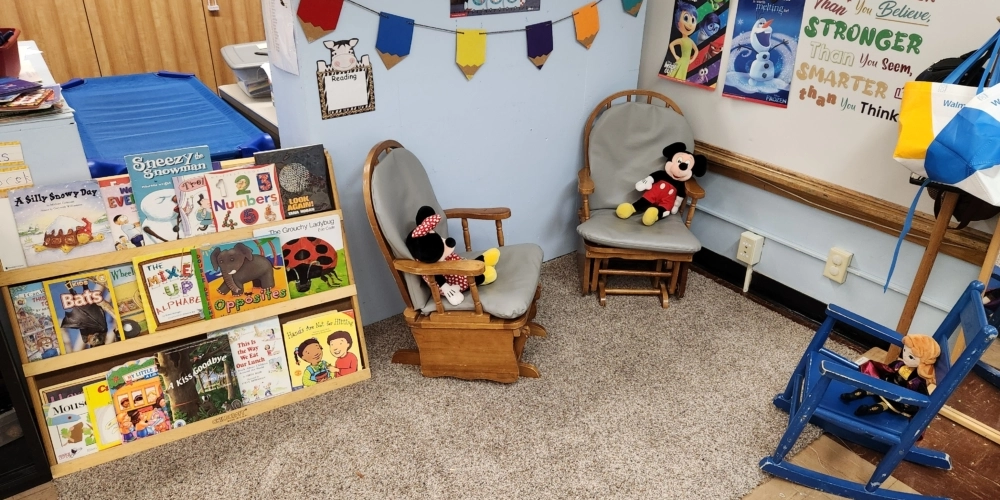
Sua sala de aula perfeita está a um clique de distância!
Tornando os centros de alfabetização pré-escolar fáceis de usar e gerenciar
Criar um layout bonito para seus centros de alfabetização pré-escolar é apenas o ponto de partida. O que realmente importa é a fluidez com que eles funcionam dia após dia — se as crianças conseguem se movimentar com confiança, se os professores conseguem se afastar sem caos e se os materiais permanecem funcionais.
Esses centros devem se integrar ao seu ritmo diário, ajudando as crianças a explorar a linguagem de forma independente, ao mesmo tempo em que liberam os educadores para observar, apoiar e transmitir instruções intencionais. Abaixo, apresentamos três estratégias essenciais que refletem a abordagem realista do professor e tornam os centros de alfabetização pré-escolar fáceis de usar e administráveis.
1. Estabeleça um sistema de rotação e um cronograma previsível
Criar ritmo no dia escolar reduz a confusão, ajuda nas transições e promove o engajamento.
- Em ambientes pré-escolares de meio período, o tempo no centro de alfabetização pré-escolar geralmente dura de 45 a 60 minutos, idealmente programados pela manhã, quando as crianças estão mais alertas.
- Usar cronômetros visuais, sinos na sala de aula ou até mesmo ampulhetas simples ajuda as crianças a entender quando é hora de girar, sem lembretes constantes de adultos.
- Combine sinais baseados em tempo com rotinas claras: por exemplo, "Rotação 1: Mesa de Escrita", "Rotação 2: Cantinho da História" e assim por diante. As crianças aprendem o fluxo por meio da repetição.
- Muitos professores utilizam um sistema de rotação no sentido horário, com os centros dispostos geograficamente pela sala. As crianças se movem de uma estação para a outra em uma ordem consistente.
- Essa rotina funciona em conjunto com uma sinalização clara ou um cronograma de bolso. Quando as crianças sabem exatamente para onde ir e quanto tempo ficar, as creches funcionam sem problemas.
2. Equilibre o uso independente com o envolvimento em pequenos grupos
Tanto o acesso independente quanto a interação guiada são vitais em centros de alfabetização pré-escolar.
- Tempo independente permite que as crianças explorem em seu próprio ritmo: escolhendo livros, traçando letras e navegando por cartões de palavras. Ela promove a autonomia e incentiva o envolvimento repetido e confortável.
- Sessões para pequenos grupos, idealmente de 2 a 4 crianças, permite que você crie estruturas, modele a linguagem e introduza novos materiais ou estratégias.
- Pesquisas mostram consistentemente que a instrução em pequenos grupos melhora a participação ativa, permite feedback imediato e apoia o aprendizado diferenciado.
- Busque flexibilidade. Comece o ano orientando pequenos grupos no centro de alfabetização pré-escolar e, gradualmente, faça a transição para escolhas mais abertas à medida que as crianças dominam as rotinas.
- Alterne o foco dos pequenos grupos com base nas necessidades das crianças — algumas semanas podem se concentrar em fonética, outras em contação de histórias ou sugestões de escrita — para que os materiais pareçam novos e úteis.
3. Capacite as crianças para gerenciar materiais e assumir a responsabilidade
Quando as crianças sabem como manusear e cuidar dos materiais, o centro se transforma em uma comunidade de aprendizagem, em vez de uma estação gerenciada pelo professor.
- No início do ano, demonstre exatamente como usar, explorar e guardar os materiais. Pratique retirar um item, usá-lo e devolvê-lo corretamente.
- Considere designar "ajudantes de centro" a cada semana. Eles podem verificar se os livros foram devolvidos, se os marcadores estão tampados ou se as lixeiras estão organizadas.
- Use etiquetas com imagens reais e palavras escritas para que as crianças possam facilmente associar os itens aos lugares, mesmo antes de aprenderem a ler em voz alta.
- Incentive as crianças a resolver pequenos problemas sem a intervenção de um adulto: “Se as pranchetas estiverem cheias, escolha uma superfície diferente” ou “Se o limite feito com blocos estiver irregular, você pode consertá-lo”.
- Essa abordagem de cogestão não apenas alivia a carga de trabalho dos professores, mas também cria responsabilidade e respeito pelo espaço.
Quando as rotinas são consistentes, o uso é intuitivo e a autoridade é compartilhada, os centros de alfabetização pré-escolar operam com fluidez. As crianças retornam com frequência, exploram mais profundamente e constroem confiança tanto nos materiais quanto em sua própria capacidade de lidar com eles.
Este é o ponto em que os centros realmente se tornam centros de aprendizagem — as crianças não apenas “brincam” lá; elas leem, escrevem, perguntam e retornam a eles repetidamente como espaços familiares e confiáveis.
Erros comuns a evitar ao criar centros de alfabetização
Um centro de alfabetização bem projetado para a primeira infância não se resume apenas ao que você inclui, mas também ao que você evita. Mesmo com ótimos materiais, um centro mal organizado pode fracassar. Aqui estão três armadilhas comuns — e como evitá-las ao montar seus centros de alfabetização pré-escolar.
1. Evite tornar o espaço muito pequeno ou desorganizado
É tentador espremer muita coisa num cantinho pequeno, mas isso costuma sair pela culatra. Quando o espaço é muito apertado ou lotado, as crianças se sentem sobrecarregadas e podem evitar completamente o centro.
Em vez disso, escolha um espaço modesto, mas convidativo — idealmente de 3 a 5 m² — ou até mesmo um cantinho com limites claros. Mantenha-o organizado. Por exemplo, se a escrivaninha estiver abarrotada de ferramentas, as crianças podem se sentir presas e se desligar.
Dica de espaço: Deixe espaço para respirar no centro. Um pequeno tapete, um expositor baixo para livros e 1 a 2 caixas de materiais tornam o ambiente aberto e acolhedor. Essa abertura incentiva a exploração e a aprendizagem autodirigida — dois pontos fortes de centros de alfabetização pré-escolar eficazes.
2. Não se limite a materiais únicos ou nunca rotacionados
Outro erro é oferecer apenas uma atividade ou não atualizar os materiais regularmente. Um centro de alfabetização pré-escolar estático logo perde sua força.
As crianças adoram novidades. Alterne materiais como lembretes de histórias, cartões temáticos com palavras ou papel de carta divertido a cada uma ou duas semanas. Talvez você possa oferecer um kit de histórias para a estação no outono ou um pacote de cartas com tema natalino em dezembro.
Você não precisa de um orçamento alto — basta trocar por um ou dois itens novos. A mudança reacende o entusiasmo e ajuda as crianças a revisitarem o centro com interesse renovado, reforçando seu lugar como parte fundamental dos seus centros de alfabetização pré-escolar.
3. Evite usar móveis inadequados para crianças
Esse erro pode ser sutil e fácil de ignorar. Móveis muito altos, duros ou bambos transmitem involuntariamente a mensagem: "Isto não é para você".
Usar cadeiras de tamanho adulto, prateleiras fundas ou mesas rígidas desestimula o uso independente. Em vez disso, escolha móveis que se adaptem ao corpo e às necessidades das crianças — mesas baixas, assentos macios e prateleiras voltadas para a frente.
As crianças têm maior probabilidade de retornar à creche quando se sentem confortáveis e fisicamente apoiadas. Esse conforto cria consistência no funcionamento diário dos centros de alfabetização pré-escolar.
Ao evitar essas três armadilhas comuns — layouts superlotados, materiais estagnados e móveis inadequados — você contribui para um espaço de aprendizagem convidativo, significativo e duradouro. Essas estratégias tornam seus centros de alfabetização pré-escolar não apenas bem projetados, mas também sustentáveis. As crianças aprendem que este centro é um espaço feito para elas — acessível, em constante evolução e que vale a pena retornar todos os dias.
Ideias para Centros de Alfabetização Sazonais e Temáticos
Um centro de alfabetização pré-escolar forte não se constrói de uma vez e fica abandonado. Para manter as crianças engajadas, animadas e com dificuldades de desenvolvimento, esses espaços precisam se adaptar ao longo do ano. A melhor maneira de fazer isso é adequar seu centro às estações do ano, aos feriados e aos temas da sala de aula.
Abaixo estão ideias reais, testadas em sala de aula, sobre vários temas — cada uma projetada para fazer com que a leitura e a escrita pareçam relevantes, alegres e parte da vida cotidiana.
Ideias para o Centro de Alfabetização Pré-escolar da Primavera
A primavera é cheia de crescimento e curiosidade — temas perfeitos para leitores iniciantes.
- Murais de Palavras com Temas da Natureza: Publique imagens de flores, insetos, nuvens e capas de chuva. As crianças adoram associar imagens a palavras, especialmente quando os objetos aparecem no mundo delas.
- Sugestões para escrever pacotes de sementes: Convide os alunos a escrever sobre o que eles cultivariam, usando pacotes de sementes reais ou ilustrados como inspiração.
- Caça ao tesouro de alfabeto ao ar livre: Esconda cartões com letras laminadas no pátio de recreação ou no jardim da sala de aula e peça para as crianças associá-los aos objetos que encontrarem.
Cada atividade conecta a alfabetização à natureza, ajudando as crianças a entender que a leitura está ao redor delas.
Centros de alfabetização pré-escolar com temas de verão ou praia
Quando o ano letivo chega ao fim — ou para programas que duram o ano todo — os temas de verão trazem brilho e movimento aos seus centros de alfabetização pré-escolar.
- Cartões de correspondência de vocabulário de praia: Use recursos visuais de itens de praia (concha, protetor solar, toalha) combinados com cartões de letras para jogos de combinação de palavras e fonética.
- Estação de Escrita de Cartões Postais: Crie cartões-postais em branco com linhas simples. As crianças podem "escrever da praia" e enviá-los aos amigos da sala de aula.
- Iniciadores de Histórias do Oceano: Use instruções como “Um dia, encontrei uma concha que falava…” e deixe as crianças terminarem a história desenhando ou escrevendo.
Uma toalha azul sobre a mesa, caixas de conchas ou toalhas de praia para sentar podem trazer o oceano para dentro da sala de aula.
Centros de Alfabetização Pré-escolar de Outono
O outono oferece um vocabulário rico e inspiração visual sem depender apenas de abóboras.
- Rastreamento de folhas com escrita: As crianças traçam folhas coloridas e escrevem uma palavra descritiva em cada uma (crocante, amarela, grande, etc.).
- Classificação de palavras de outono: Forneça cartões com palavras e imagens como “esquilo”, “maçã” e “jaqueta” e peça aos alunos que os classifiquem por letra inicial ou contagem de sílabas.
- Fonética com tema de maçã: Use maçãs de papel vermelhas e verdes para segurar quebra-cabeças fonéticos ou famílias de palavras que rimam.
Essas ideias vinculam mudanças sazonais ao desenvolvimento da linguagem de maneiras sutis, mas significativas.
Centros de Alfabetização Pré-escolar de Natal
Os centros de alfabetização pré-escolar durante as férias podem ser ricos em histórias, conexão emocional e escrita expressiva.
- Cartas para o Papai Noel: Forneça artigos de papelaria festivos e incentive as crianças a escrever cartas ou desenhar listas de desejos, promovendo a escrita emergente e a expressão emocional.
- Correspondência de vocabulário de Natal: Use cartões ilustrados com palavras como “trenó”, “sino”, “presente” e “árvore”. Deixe as crianças associarem a palavra à imagem ou classificarem pela letra inicial.
- Recontando histórias de férias: Recontar clássicos como O Homem-Biscoito de Gengibre ou A Noite Antes do Natal com fantoches, quadros de flanela ou tiras de sequenciamento.
- Sugestão de escrita para pote de desejos:Peça para as crianças escreverem ou desenharem o que gostariam de desejar a um amigo ou familiar durante as festas de fim de ano.
Use luzes simples, cartões com palavras temáticas natalinas ou recortes de neve para dar um toque festivo ao espaço sem desviar a atenção dos objetivos de alfabetização. Quando integrados de forma inteligente, os temas natalinos aumentam a motivação e aprofundam as habilidades de contar histórias, tornando os centros de alfabetização pré-escolar mais mágicos do que nunca.
Centros de Alfabetização Pré-escolar de Halloween
O Halloween traz uma mistura de diversão e terror, perfeita para escrita criativa e brincadeiras iniciais de fonética.
- Palavras rimadas da poção da bruxa: Misture caldeirões de plástico e cartões com palavras que rimam. As crianças "misturam" pares correspondentes, como morcego-gato ou neblina-tronco.
- Sequenciamento de Histórias Assustadoras: Use ilustrações com tema de Halloween para ajudar as crianças a recontar uma história assustadora simples em ordem.
- Classificação de sons de letras: Peça para as crianças separarem as imagens do Halloween em caixas rotuladas pelos sons iniciais (por exemplo, fantasma em sol, esqueleto em sol).
A decoração pode ser tão simples quanto papel roxo, pequenos anéis de aranha ou letras que brilham no escuro para manter o clima festivo.
Centros de Alfabetização Pré-escolar para as Férias de Páscoa e Primavera
A Páscoa oferece oportunidades de misturar símbolos, histórias e diversão sensorial.
- Caça às Letras dos Ovos Escondidos: Encha ovos de plástico com letras ou palavras e deixe as crianças “caçá-los” pela sala de aula.
- “Se eu tivesse um coelho…” Sugestões: Use adesivos ou desenhos de coelhos para criar histórias sobre como cuidar de um animal de estimação imaginário.
- Tapetes para construção de palavras de Páscoa: Forneça tapetes com tema de primavera com palavras como “pulo”, “ovo” ou “grama” e peças com letras para as crianças construírem.
É uma maneira suave e alegre de contar histórias em uma temporada cheia de energia.
Centros de Alfabetização de Abóbora para Pré-escola
As abóboras oferecem um tema rico para o aprendizado focado em outubro e outono. Elas são visuais, sensoriais e repletas de oportunidades para conectar a alfabetização a experiências do mundo real.
- Sequenciamento da história da abóbora: Use cartões ilustrados simples que mostrem uma abóbora crescendo, da semente à abóbora-lanterna. Peça às crianças que os organizem e recontem o processo.
- Classificação de letras de abóbora: Forneça mini abóboras ou recortes com letras maiúsculas e minúsculas. As crianças podem formar pares ou classificar por vogal/consoante.
- Mural de Palavras com Tema de Abóbora: Apresente novas palavras sazonais como “cabaça”, “colheita”, “remendo” e “caule” com recursos visuais e definições.
- Escreva sua própria história de abóbora: Ofereça livretos em branco e um prompt como “Um dia, me perdi em um canteiro de abóboras…” para escrita guiada.
Decore com abóboras de verdade ou de papel, caixas de armazenamento laranja ou tecidos temáticos. Essas pequenas mudanças trazem o outono para dentro de casa e renovam os centros de alfabetização pré-escolar.
Centros de Alfabetização Pré-escolar com Temas Culturais e Mundiais
Diversos ambientes de sala de aula se beneficiam de oportunidades de alfabetização cultural durante todo o ano.
- Cartões de felicitações multilíngues: Crie cartões simples que digam “olá” ou “obrigado” em diferentes idiomas e incentive as crianças a copiá-los ou enviá-los.
- Livretos de férias: Convide as crianças a criarem mini livros “Tudo Sobre Mim” relacionados às tradições ou festivais de suas famílias.
- Bandeiras de palavras: Use bandeiras de países impressas e anexe palavras simples ou saudações em idiomas nativos e, em seguida, combine-as em um mapa-múndi.
Esses projetos apoiam a alfabetização, a inclusão e a aprendizagem social ao mesmo tempo.
Dicas para gerenciar atualizações sazonais
- Gire apenas 1–2 elementos por vez (cartões de vocabulário, sugestões de escrita, adereços).
- Armazene os kits sazonais em recipientes etiquetados — fáceis de colocar e retirar.
- Mantenha o mobiliário principal igual para que as crianças se sintam confiantes mesmo quando o conteúdo muda.
Ao mudar o conteúdo, mas mantendo a estrutura, seus centros de alfabetização pré-escolar permanecem dinâmicos sem se tornarem sobrecarregados.
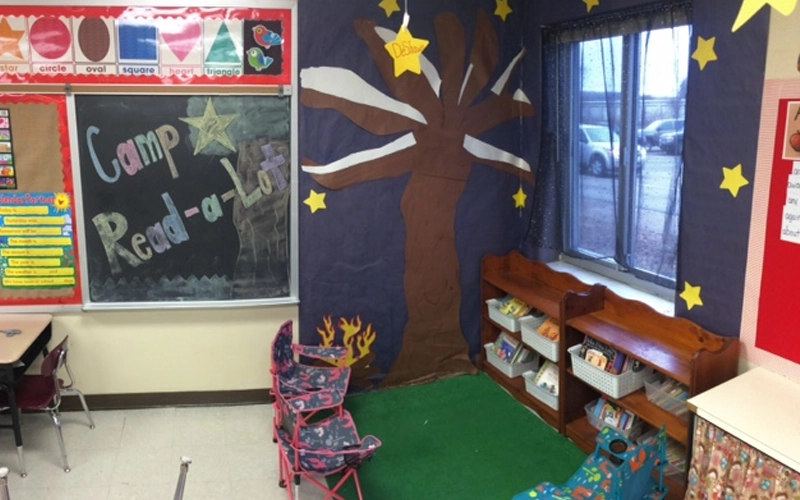
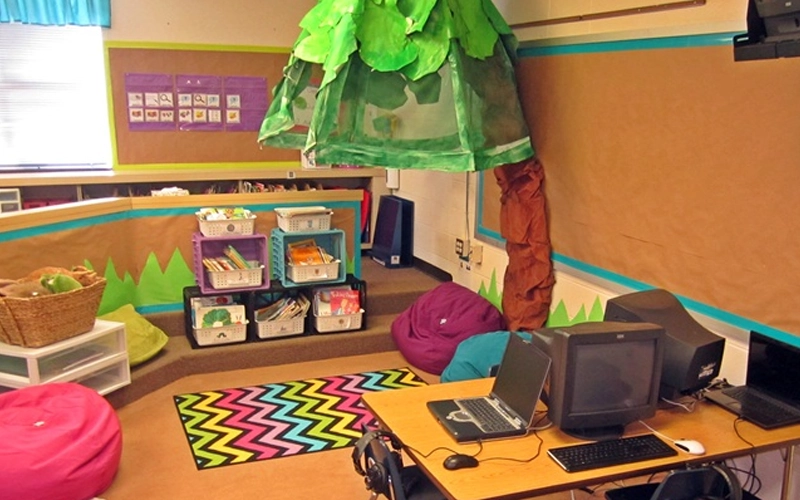
Conclusão
Criar centros de alfabetização pré-escolar eficazes não significa ter móveis perfeitos como os do Pinterest ou um suprimento infinito de materiais. Trata-se de construir espaços que reflitam como as crianças aprendem melhor: por meio de brincadeiras, independência e conexão significativa.
Quando seus centros são cuidadosamente organizados, fáceis de gerenciar e atualizados por meio de temas sazonais, eles se tornam mais do que apenas cantos da sala de aula: eles se tornam centros de linguagem, curiosidade e imaginação.
Não importa o seu orçamento, o tamanho da sala de aula ou o seu estilo de ensino, você pode criar centros de alfabetização pré-escolar inspiradores. Comece com o que você tem, ajuste com intenção e lembre-se de que as crianças sempre responderão a espaços que pareçam feitos sob medida para elas.
Porque na primeira infância, um canto tranquilo cheio de letras, histórias e possibilidades nunca é apenas um canto — é onde a alfabetização começa.
Perguntas frequentes
Em que idade é melhor introduzir centros de alfabetização pré-escolar?
Centros de alfabetização pré-escolar podem ser introduzidos já a partir dos 3 anos de idade, mas o fundamental é adaptar as atividades e os materiais à prontidão do desenvolvimento. Para crianças em idade pré-escolar, os centros devem se concentrar na exposição — livros, sons das letras e contação de histórias. À medida que as crianças crescem, tarefas de escrita e sequenciamento podem ser adicionadas gradualmente.
Quanto tempo as crianças devem passar em um centro de alfabetização pré-escolar por dia?
Não há um tempo fixo, mas 10 a 20 minutos por sessão é o ideal para a maioria das crianças em idade pré-escolar. Os centros de alfabetização pré-escolar funcionam melhor quando as crianças podem revisitá-los ao longo do dia, em vez de ficarem restritas a um único bloco.
Preciso de uma sala dedicada para centros de alfabetização pré-escolar?
De jeito nenhum. Muitos centros de alfabetização pré-escolar eficazes ficam escondidos nos cantos das salas de aula, sob janelas ou até mesmo compartilhados com áreas de teatro ou artes. O segredo é criar limites visuais e expectativas claras — não o tamanho.
E se as crianças perderem o interesse no centro com o tempo?
Isso é comum e geralmente resolvido com pequenas mudanças. Troque os materiais semanalmente, ajuste a iluminação ou troque a disposição dos assentos. As crianças respondem rapidamente a novidades, especialmente quando se sentem donas do espaço.
Como posso tornar os centros de alfabetização inclusivos para alunos multilíngues?
Use etiquetas com imagens, cartões de vocabulário bilíngue e permita que as crianças "escrevam" em sua língua materna ou com desenhos. Incluir livros e materiais de diferentes culturas ajuda cada criança a se sentir vista e incluída.
Os centros de alfabetização pré-escolar ainda são eficazes em salas de aula digitais ou ambientes de ensino domiciliar?
Sim. O conceito se adapta bem ao aprendizado em casa ou virtual. Um "centro" pode ser uma cesta portátil, uma mesa com lembretes rotativos ou até mesmo um desafio diário de alfabetização compartilhado na tela. Os princípios — escolha, independência e variedade — ainda se aplicam.



